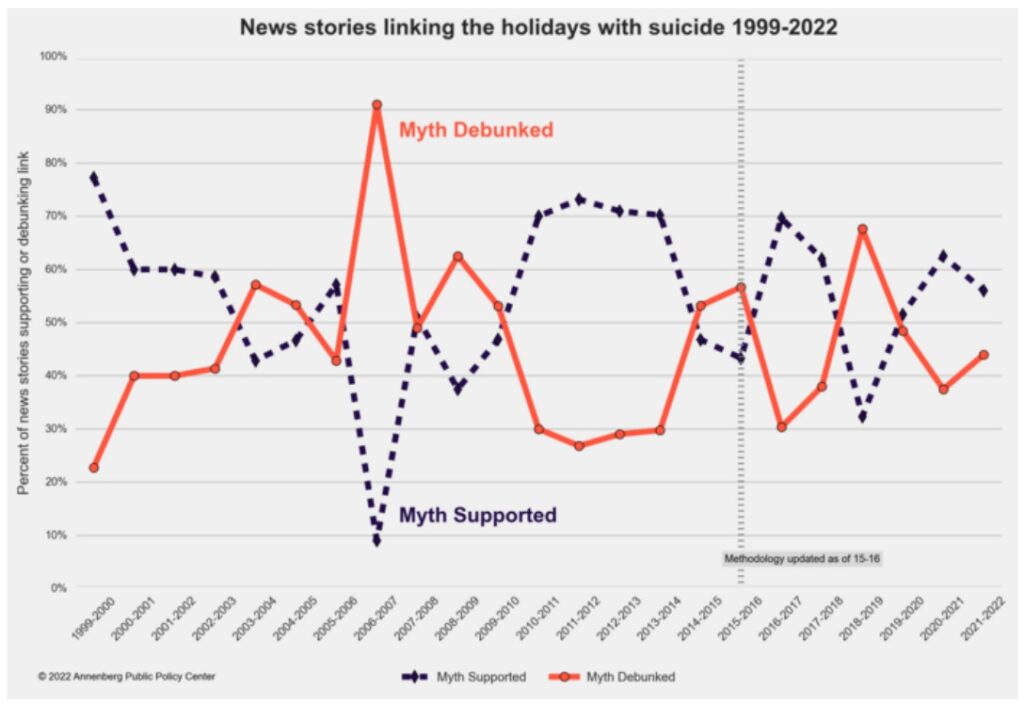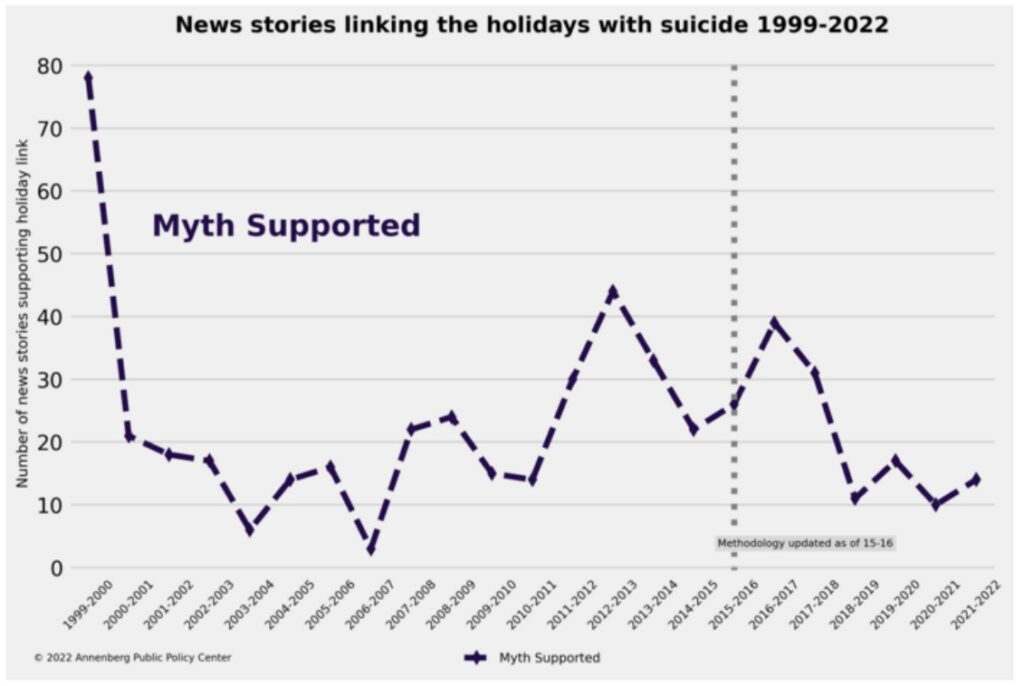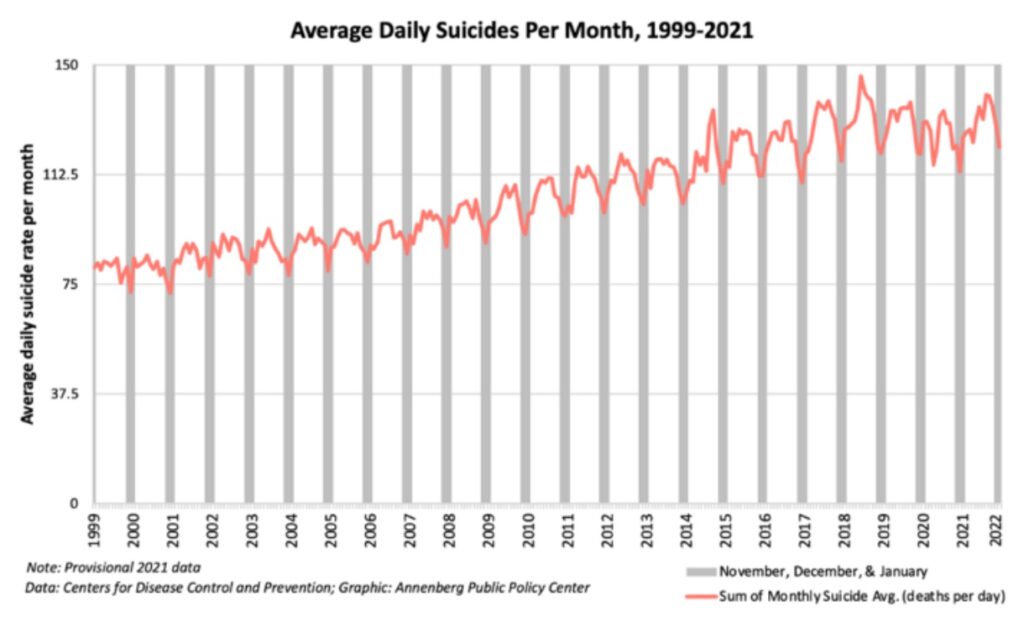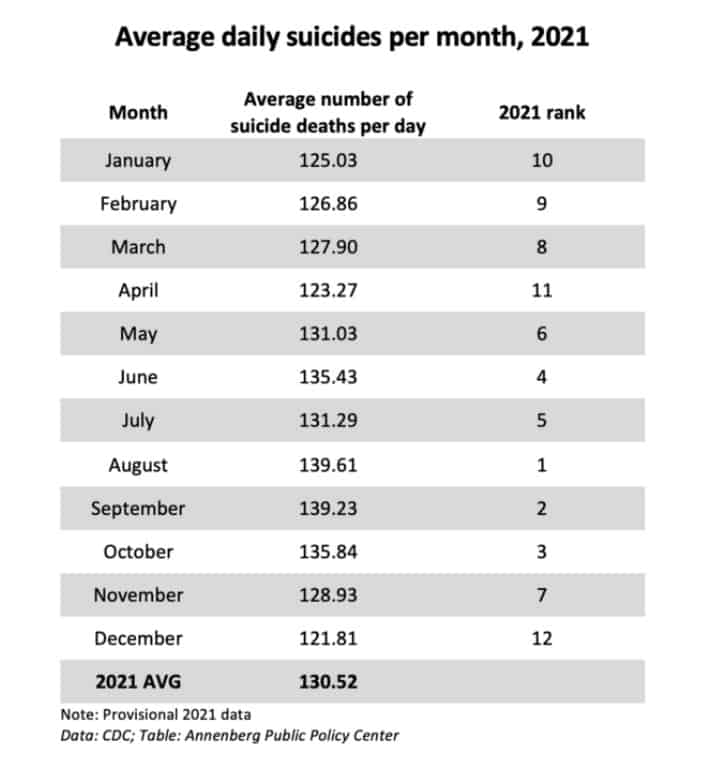According to statistics compiled and evaluated, the holiday-suicide myth, the misleading claim that the suicide rate climbs around the year-end holidays, existed in some news coverage as recently as the 2021-22 season.
Though the suicide rate in the United States rose in 2021 after two consecutive years of reduction, it remained among the lowest rates of the year on average throughout the Christmas season.
The media analysis conducted by APPC, which is based on newspaper articles published during the holiday season of 2021–2022, discovered that slightly more than half of the articles that specifically addressed the holidays and the suicide rate supported the myth while the remaining articles debunked it.
More than two decades ago, the Annenberg Public Policy Center began studying newspaper articles to see whether or not they contributed to the development of the holiday-suicide myth. Only 25 reports made the link during the Christmas season of 2021–2022, with 14 of them upholding the myth (56%) and six dispelling it (37%); this is one of the lowest totals recorded since APPC began keeping track of this.
“Our experience in tracking news stories about suicide over the holidays shows how difficult it is stamp out this myth,” remarks Dan Romer, research director of the Annenberg Public Policy Center. “In the 23 years of our study, only nine years had higher rates of debunking of the myth and only three of those occurred in the last 10 years.”

The U.S. suicide rate continues to grow
According to preliminary statistics from the Centers for Disease Control and Prevention (CDC), suicide rates rose in 2021 after falling in 2019 and 2020. In 2021, however, the age-adjusted national suicide rate was not greater than its previous peak in 2018 (14.0 per 100,000 population in 2021 vs. 14.2 in 2018).
The Covid-19 epidemic was proclaimed in 2020, prompting lockdowns in portions of the United States. The National Center for Health Statistics of the CDC reported preliminary statistics in September 2022 that indicated there were 4% more suicides in 2021 than there were in 2020.
The CDC said that although the overall number of suicides increased in 2021 compared to 2020, only January, February, and July saw an increase.
When compared to the other 11 months in 2021, the number of suicide fatalities in the United States between January and December is quite low, ranking 10th and 12th, respectively. In 2021, November had the seventh-highest rate of suicide out of all 12 months. August of 2021 had the greatest number of suicides.
This time of year may be emotionally challenging for some individuals, according to Romer.
“With stories focusing on the holiday blues, seasonal affective disorder, and other changes in the seasons, there are a lot of factors that would seem to support the myth,” highlights the author, adding, there is also concern for those who have lost friends and family during the year and who may be experiencing sadness about those losses. But we should not assume that these experiences lead people to suicide.”
At the same time, the pandemic made people even more worried and sad, especially young people.

According to surveys done by the U.S. Census Bureau and the National Center for Health Statistics, 47.5% of 18- to 29-year-olds in the United States had signs of an anxiety disorder or a depressive disorder from December 29, 2021, to January 10, 2022. During the same time, the overall rate in the U.S. was 32.1%.
Holiday-suicide myths
The myth of holiday suicide has been the subject of an analysis by APPC that spans 23 holiday seasons, from 1999–2000 through 2021–2022. Over the holidays in most of those years, more media pieces confirmed the belief than dispelled it.
In cases like these, the misleading link between holidays and suicide is evident.
- In a question-and-answer column published Dec. 22, 2021, in the Highland (Ill.) News Leader, Focus on the Family president Jim Daly responded to a question from someone who was not feeling particularly merry by saying: “I get it – for every festive party and joyous carol this Christmas season, there will be someone out there who, for various reasons, just barely makes it through. And unfortunately, some WON’T make it through – the numbers show that depression and suicide rates peak this time of year.”
- In “The Bright Side: Happy Thanksgiving,” which ran on Nov. 23, 2021, in the Spencer (Ind.) Evening World, guest columnist Anne Bright wrote about the causes of holiday stress: “Most experts agree that unrealistic expectations are a major contributor. The over-commercialization of the holidays has led us to believe that our lives should be a ‘Hallmark’ TV special. Add financial stress, toxic family situations, fatigue, loneliness, and unhealthy eating habits and the situation can become critical. Depression and suicide increase dramatically during the ‘jolly’ season.”
The following accounts dispel the myth:
- A guest column by Chris Schillig in The (Ohio) Alliance on Dec. 11, 2021, noted: “It is often said that suicides increase near the holidays, but this is not accurate. Suicide attempts decrease at Christmastime and peak in the summer months. Still, the warning signs should never be overlooked.”
- A Dec. 18, 2021, story in The (Va.) Winchester Star about suicide prevention help being available year-round, said, “While people may think suicides increase during the holidays, statistics show otherwise.” The story went on to cite CDC monthly suicide data and the Annenberg Public Policy Center’s 2018 findings.
Why debunking the holiday suicide myth is crucial

Reporters and news organizations must debunk this myth because it may have a contagious impact on those who are thinking about suicide by leading others to believe that suicide is more frequent during the holidays.
National guidelines for how to report on suicide say that journalists shouldn’t spread information that can make suicide more contagious, like reports of epidemics or seasonal rises, especially when the claim has no basis in fact.
According to the national guidelines, which were developed by organizations involved in journalism, suicide prevention, and the Annenberg Public Policy Center, journalists should obtain information on suicide rates from trustworthy sources like the CDC and provide details on resources that can assist those in need.

Journalists who contribute to debunking the holiday-suicide myth may direct readers in need of helpful options. The CDC, the Suicide Prevention Resource Center, the National Institute of Mental Health, and the Substance Abuse and Mental Health Services Administration (SAMHSA) are all good places to get useful information. The National Suicide Prevention Lifeline changed its name to the 988 Suicide & Crisis Lifeline in July 2022, and the hotline’s three-digit national telephone number, 9-8-8, was formally introduced.
The methodology used in the study
Searches of the LexisNexis and NewsBank databases turned up news and feature articles that related suicide to the holidays. From November 15, 2021, to January 31, 2022, the researchers employed the search phrases “suicide” or “suicides” with variations of the words “holiday,” “Christmas,” “New Years,” “increase,” “peak,” and “rise.”
In order to include more of the American press, NewsBank was added to the APPC searches in 2019 in addition to the LexisNexis database that they had previously utilized. The percentage of articles dispelling or supporting the myth did not significantly change after a reanalysis of earlier years since 2015–16, including NewsBank.
Researchers examined whether the accounts confirmed the connection, refuted it, or just made an unrelated remark. Coincidence-related tales were dropped. Only domestic suicides were included; for example, suicide bombings abroad were not included.
Image Credit: Getty
